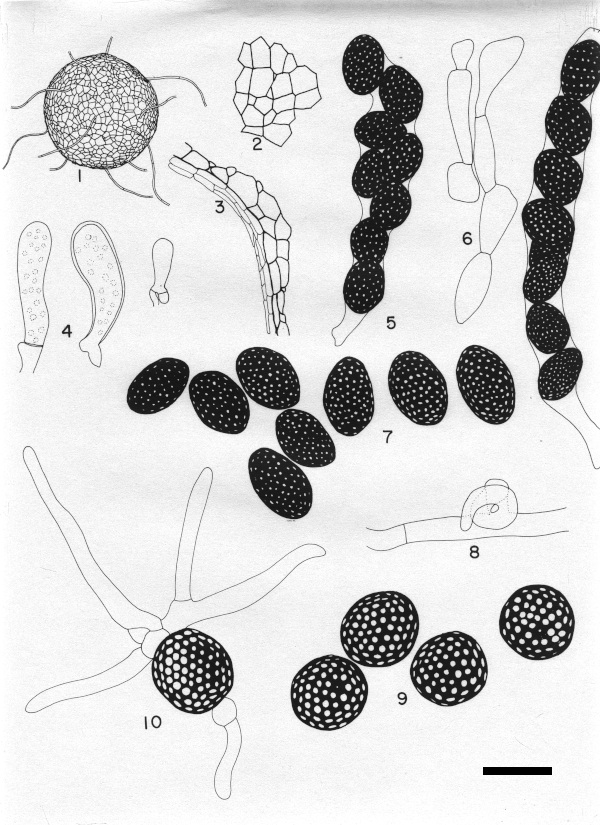Essays >> Cleistothecial Ascomycota >> Cleistothecial Ascomycota - Plate 02
Cleistothecial Ascomycota - Plate 02

1-7. Neurospora reticulata (C. Booth & Ebben) D. García, Stchigel & Guarro
1. Ascoma (X 165). 2. Surface of the peridium (X 825). 3. Cross section of the peidium (X 825). 4. Immature asci with croziers (X 825). 5. Mature asci (X 633). 6. Paraphyses-like elements (X 825). 7. Ascospores (X 825).
8-10. Neurospora indica (J.N. Rai, Wadwhani & J. P. Tewari) D. García, Stchigel & Guarro
8. Ascomatal initials (X 825) 9. Ascospores (X 825). 10. Germinating ascospore (X 825).
Originally described as a species of Thielavia by Booth & Ebben (Trans. Brit. Mycol. Soc. 44: 214. 1961), N. reticulata was transferred to Anixiella by Cain (Can. J. Bot. 39: 1667. 1961), by Cailleux (Bull. Soc. Mycol. France 87: 534. 1971) to Gelasinospora and finally by García et al. (Mycol. Res. 108: 1132. 2004) to Neurospora. This sequence of transfers illustrates clearly the evolution in taxonomic thought over 43 years.
The drawings of N. reticulata are from from a culture received by Cain from CBS (now the Westerdijk Institute) and described in his publication on Anixiella and Diplogelasinospora (Can. J. Bot. 39: 1667-1677. 1961). It is not clear from Cain's publication whether this culture was derived from CBS 435.61, the holotype (carnation stems, England) or from CBS 106.51, the type for the synonymous but illegitimate Anixiella reticulispora Saito & Minoura from soil in Japan.
Neurospora indica had a similar series of name changes, going from its original description as a species of Anixiella by J.N. Rai, Wadwhani & J. P. Tewari (Can. J. Bot. 45: 479. 1967) to Gelasinospora by Arx (Proc. K. ned. Akad. Wet., ser. C 76: 292. 1973) and finally to Neurospora by García et al. (Mycol. Res. 108: 1132. 2004).
Drawings of N. indica are from TRTC 45305, a dried specimen from a culture sent to R.F. Cain by J.N. Rai. The culture was isolated from soil in Lucknow, India.
García et al. (Mycol. Res. 108: 1119-1142. 2004) included both of these species in their key to Neurospora species.